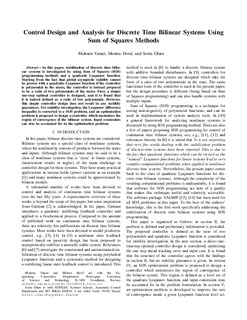| dc.contributor.author | Vatani, Mohsen | |
| dc.contributor.author | Hovd, Morten | |
| dc.contributor.author | Olaru, Sorin | |
| dc.date.accessioned | 2015-01-13T14:14:25Z | |
| dc.date.accessioned | 2015-06-02T11:50:17Z | |
| dc.date.available | 2015-01-13T14:14:25Z | |
| dc.date.available | 2015-06-02T11:50:17Z | |
| dc.date.issued | 2014 | |
| dc.identifier.citation | IEEE Proceedings : Conference on Decision and Control (CDC) 2014 | nb_NO |
| dc.identifier.issn | 0191-2216 | |
| dc.identifier.uri | http://hdl.handle.net/11250/284408 | |
| dc.description.abstract | In this paper, stabilization of discrete time bilinear systems is investigated by using Sum of Squares (SOS)
programming methods and a quadratic Lyapunov function.
Starting from the fact that global asymptotic stability cannot
be proven with a quadratic Lyapunov function if the controller
is polynomial in the states, the controller is instead proposed
to be a ratio of two polynomials of the states. First, a simple
one-step optimal controller is designed, and it is found that
it is indeed defined as a ratio of two polynomials. However,
this simple controller design does not result in any stability
guarantees. For stability investigation, the Lyapunov difference
inequality is converted to a SOS problem, and an optimization
problem is proposed to design a controller which maximizes the
region of convergence of the bilinear system. Input constraints
can also be accounted for in the optimization problem. | nb_NO |
| dc.language.iso | eng | nb_NO |
| dc.publisher | Institute of Electrical and Electronics Engineers (IEEE) | nb_NO |
| dc.title | Control Design and Analysis for Discrete Time Bilinear Systems using Sum of Squares Methods | nb_NO |
| dc.type | Journal article | nb_NO |
| dc.type | Peer reviewed | en_GB |
| dc.date.updated | 2015-01-13T14:14:25Z | |
| dc.source.pagenumber | 3143 - 3148 | nb_NO |
| dc.source.journal | IEEE Conference on Decision and Control | nb_NO |
| dc.identifier.doi | 10.1109/CDC.2014.7039874 | |
| dc.identifier.cristin | 1196885 | |
| dc.description.localcode | This is the authors accepted and refereed manuscript to the article. (c) 20xx IEEE. Personal use of this material is permitted. Permission from IEEE must be obtained for all other users, including reprinting/ republishing this material for advertising or promotional purposes, creating new collective works for resale or redistribution to servers or lists, or reuse of any copyrighted components of this work in other works. | nb_NO |
